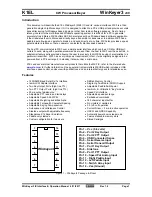
Measurement Results
14
SWRA523B – September 2016 – Revised March 2017
Copyright © 2016–2017, Texas Instruments Incorporated
CC13xx Antenna Diversity
4.3.5
Test 3
Test 3 is the same as Test 2, but with a different TX output power level to see how much the power level
had to be increased for a system not using antenna diversity to achieve the same PER as a system using
antenna diversity.
lists the PER for Test 3.
Table 8. Test 3 PER for Boards Using ANT1, ANT2, or Diversity (DIV)
Antenna
Output Power [dBm]
Number of Received
Packets
Number of Sent
Packets
PER [%]
ANT1
–46
632
3000
78.9
–42
1551
2000
22.5
–38
1971
2000
1.5
ANT2
–46
2696
3000
10.1
–42
1900
2000
5.0
–38
1983
2000
0.8
DIV
–46
2751
3000
8.3
–42
1944
2000
2.8
–38
1999
2000
0
In this test, an increase in TX power of approximately 4 dB was required to achieve the same PER for the
board connected to ANT1 as for the board using antenna diversity (–38 dBm versus
−
42 dBm,
respectively).
4.3.6
Test 4
The RX boards were placed in a fixed location. The TX board was carried around the TI office.
lists the PER for Test 4.
Table 9. Test 4 PER for Boards Using ANT1, ANT2, or Diversity (DIV)
Antenna
Number of Received Packets
Number of Sent Packets
PER [%]
ANT1
2055
3000
31.5
ANT2
2114
3000
29.5
DIV
2403
3000
19.9
The board using antenna diversity (DIV) yielded a lower PER than the single-antenna boards (ANT1 and
ANT2).



































